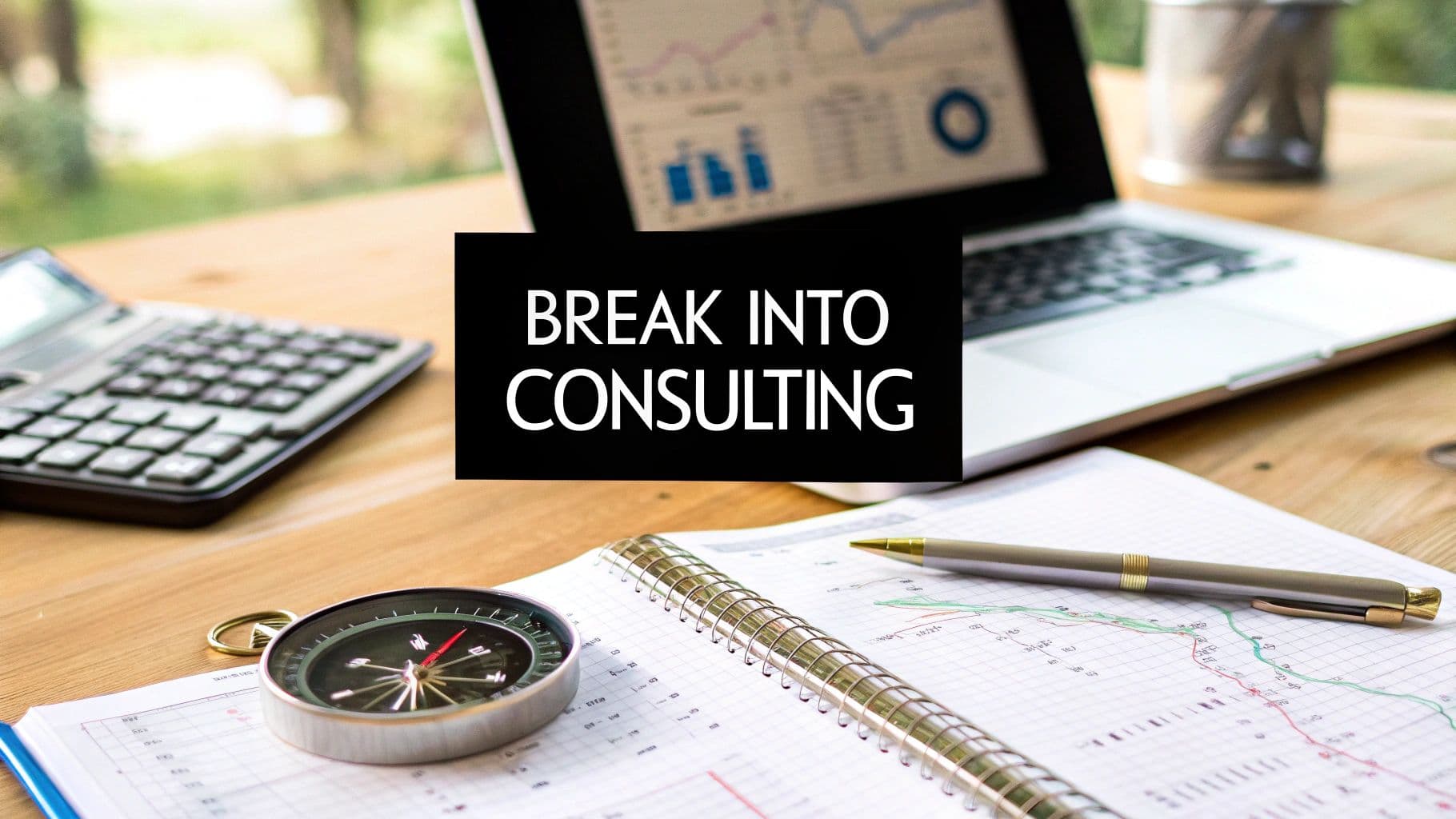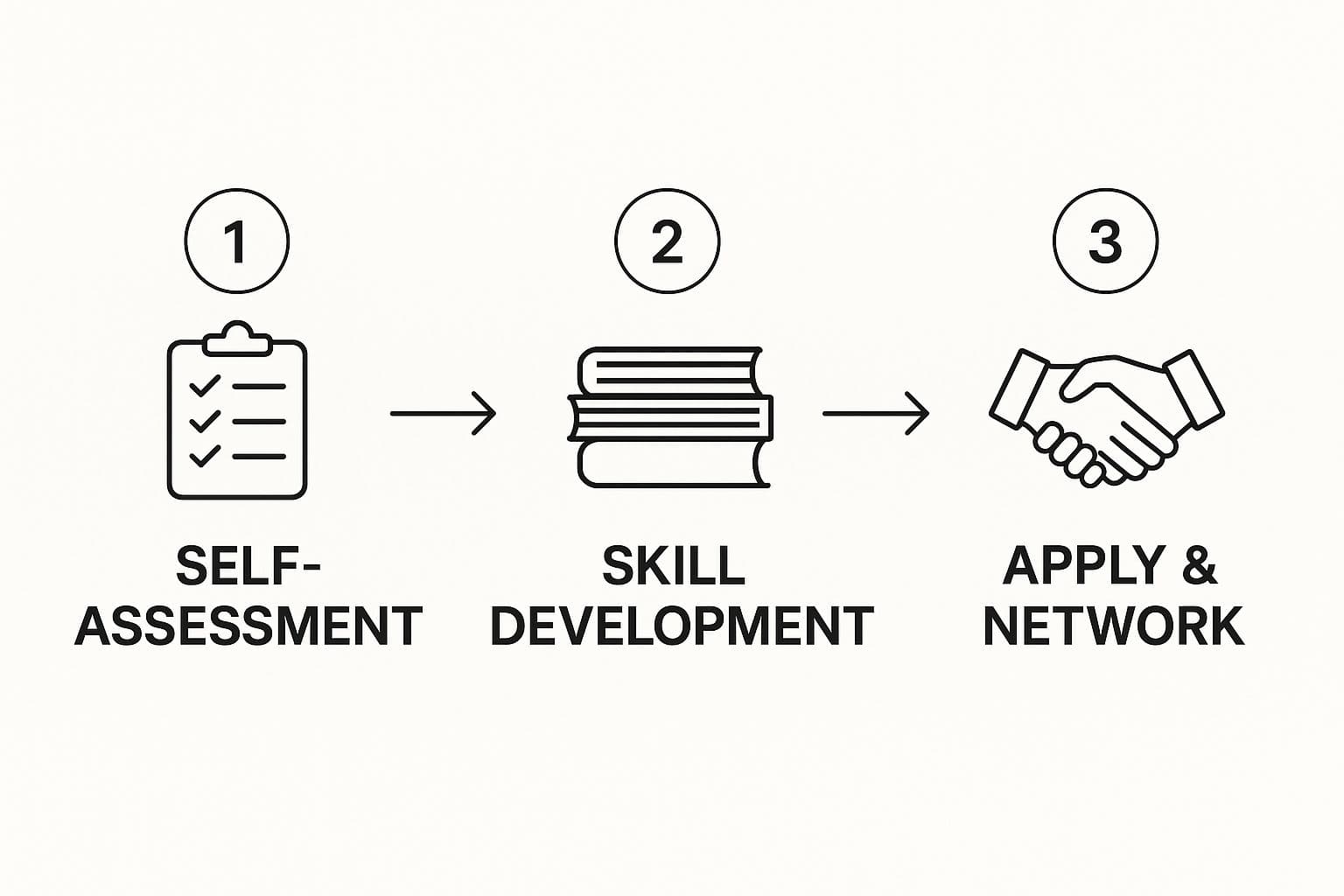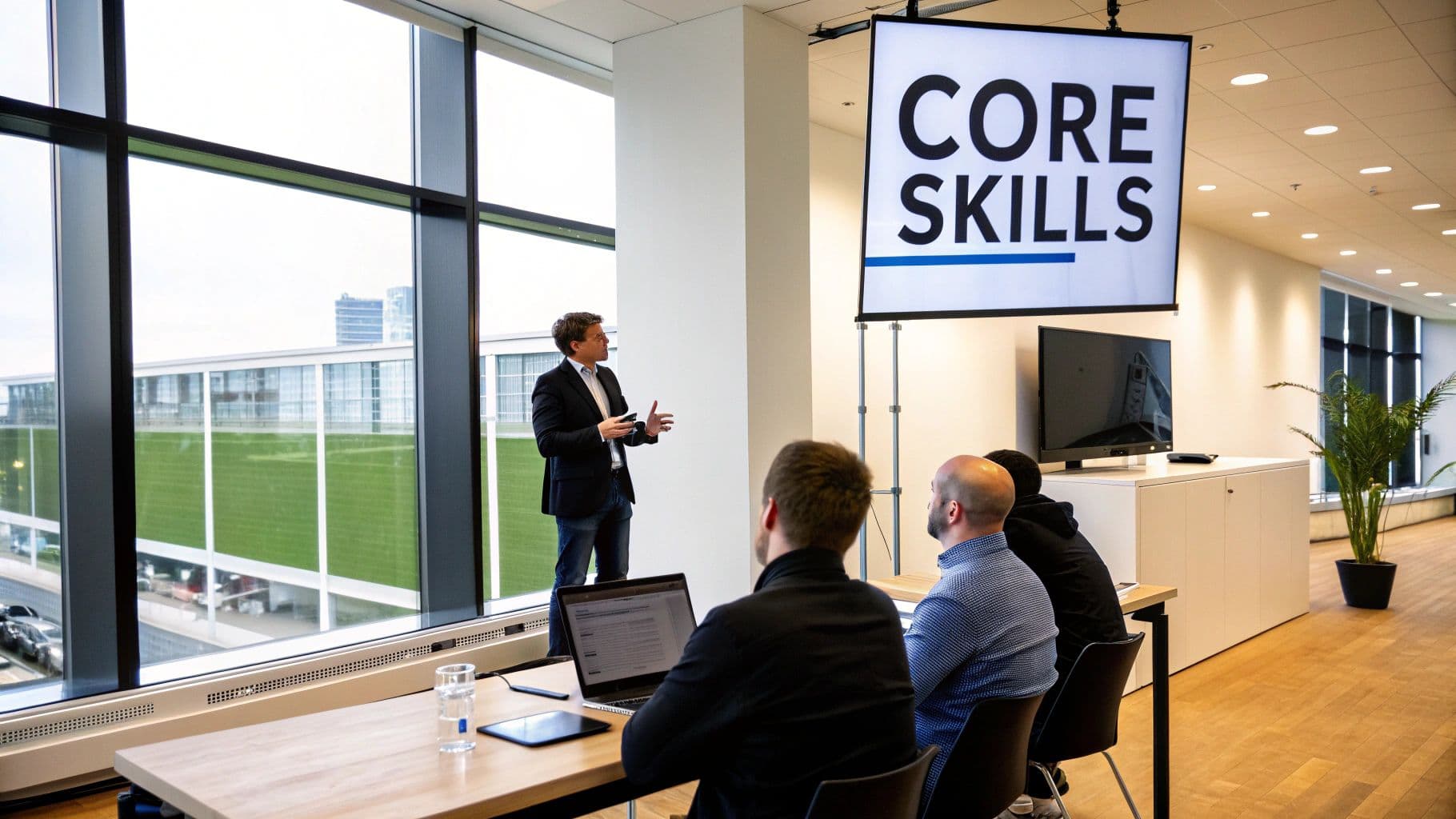How to Break Into Consulting
Discover how to break into consulting with proven strategies for networking, applications, and case interviews. Get actionable advice from industry insiders.

Breaking into the world of consulting isn't just about sending out applications; it's about running a strategic campaign. You need to build a smart network, craft an application that tells a story, and absolutely nail the case interview. Get these three things right, and you’ll go from being just another resume in the pile to a candidate firms are genuinely excited to meet.
Your Blueprint for a Consulting Career
The path to a consulting offer can seem intimidating and confusing from the outside, but it’s a process you can absolutely conquer with the right strategy. Success isn't just about a perfect GPA or a big-name school. It’s about proving you're a structured thinker who can start adding value the moment you walk through the door. This guide is here to pull back the curtain and give you a clear, actionable blueprint.
Think of it this way: the global management consulting market was valued at over $1 trillion in 2025, and it's not slowing down. That’s a lot of opportunity, but the competition is fierce. One revealing statistic is that 60% of consulting business owners land their first client through referrals. While that applies to starting a firm, it perfectly illustrates the power of connections in this industry. Networking isn't optional; it's fundamental.
This roadmap breaks down the core pillars of your journey.

As you can see, a successful push into consulting starts with some serious self-reflection before you even think about reaching out to anyone.
The Milestones of Your Journey
To help you visualize the road ahead, here's a breakdown of the key stages you'll navigate. Think of it as a series of building blocks; each one sets you up for success in the next.
| Milestone | Objective | Key Activities |
|---|---|---|
| Phase 1: Research & Self-Assessment | Find your fit and identify your gaps. | Dive deep into firm cultures (MBB vs. boutique), talk to current consultants, and honestly assess your analytical and communication skills against what firms demand. |
| Phase 2: Build & Brand | Fill skill gaps and craft your personal story. | Take on data-heavy projects, lead a team, and start practicing case interviews. Translate these experiences into a compelling "consulting-ready" narrative for your resume and networking. |
| Phase 3: Network & Connect | Get on the radar and secure referrals. | Conduct informational interviews, attend industry events, and build genuine relationships with consultants at your target firms. |
| Phase 4: Apply & Interview | Convert preparation into an offer. | Tailor every single resume and cover letter, leverage your network for referrals, and intensely prepare for both case and fit interviews. |
Each of these phases is a critical step that builds momentum, taking you from initial exploration all the way to negotiating your final offer.
The most powerful thing you can do is show, not just tell. Create samples of your work as if they were consulting assignments. This demonstrates your ability to think and communicate like a consultant long before you ever sit down for an interview.
If you’re serious about landing a role at a top-tier firm, you need to understand the specific skills they're looking for. You can get a clearer picture of what it takes by exploring the different consulting careers and the core competencies required to thrive.
Building Your Strategic Network
In consulting, who you know isn't just a cliché—it’s often the most critical part of your job search. A well-placed referral from someone inside a firm can do what even the most polished resume can't: get you past the automated screening software and onto a real person's desk. This isn’t about just showing up to career fairs. It's about building genuine, strategic relationships with people who can vouch for you.
Forget simply collecting LinkedIn connections. The real goal is to turn a stranger into an advocate, someone who believes in your potential enough to put their name on the line for you. This requires targeted outreach and conversations that show you've done your homework, long before you ever click "submit" on an application.

Identify Your Key Contacts
Before you fire off a single email, you need a game plan. Randomly messaging people is a waste of your time and theirs. Instead, build a smart, targeted list of individuals at different levels within the firms you’re aiming for.
Think about who can give you the best intel. I always tell candidates to focus on these three groups:
- University Alumni: These are your warmest leads, hands down. A shared alma mater creates an immediate, natural connection, making them far more likely to respond and help out.
- Consultants in Your Target Practice: Eyeing a spot in a firm's tech strategy group? Then talk to people in that group. Your conversation will be richer, and it shows you have a specific, well-researched interest, which is always impressive.
- Recent Hires: People who were in your shoes just a year or two ago are an absolute goldmine. They have the freshest, most practical advice on navigating the current recruiting gauntlet.
Jump on LinkedIn and use the search filters to zero in on these people. Look for any shred of common ground—your university, a past employer, a shared volunteer experience. That commonality is the perfect icebreaker for your first message.
Master the Art of the Coffee Chat
Your initial outreach has one simple objective: land a 15-20 minute informational interview, often called a "coffee chat." This short conversation is your chance to learn, make a great impression, and start building a real professional relationship. Keep your first message short, respectful, and to the point.
A simple, effective message structure looks like this:
- A Clear Subject Line: Go with something direct, like "Fellow [University] Alum - Question about Your Work at [Firm Name]."
- A Quick Intro: Briefly say who you are and why you’re reaching out, immediately mentioning your shared connection.
- The Specific Ask: Request a brief call to hear about their experience, making it clear you value their time.
Once the chat is on the calendar, come prepared with smart questions. Don't ask anything you can find with a five-second Google search. Focus on their personal journey and insights. Ask about a project they found challenging, what surprised them most about the firm's culture, or what skills they see as most critical for new hires.
Pro Tip: Always wrap up your call with this killer question: "Based on our conversation, is there anyone else you think it would be helpful for me to speak with?" This single question is the most powerful tool for turning one contact into an entire internal network.
This approach transforms a single conversation into a branching tree of connections, massively boosting your visibility. Your genuine curiosity and respect for their time will make you stand out from the hundreds of other candidates all vying for the same spot.
Crafting a Standout Consulting Application
Think of your resume and cover letter as your opening argument. In the hyper-competitive world of consulting, this is your first—and sometimes only—shot to make a powerful impression. You need to build a compelling case for why you belong at their firm, translating your unique background, whether it's in engineering, marketing, or even the arts, into the language of impact and problem-solving. This isn't just a list of jobs; it's a narrative that tells recruiters, "I think like a consultant."
The standards are notoriously high. Historically, top-tier firms like McKinsey, Bain, and BCG have recruited from the top 1-2% of graduates across the globe. They're looking for razor-sharp analytical skills and a track record of excellence. While they're casting a wider net these days, that core expectation hasn't changed. Your application has to scream competence from the very first glance. You can find more great stats and trends in this management consulting industry report.

Quantify Your Impact on Your Resume
Recruiters are scanners. They give a resume a few seconds before making a snap judgment. To survive that initial scan, your achievements need to be quantified with cold, hard numbers.
A vague statement like "improved team efficiency" gets you nowhere. It’s forgettable. You have to show them the tangible results of your work. Every bullet point should tell a mini-story of action and impact.
- Structure it right: Use an Action Verb + Project + Result formula. Start with a powerful verb, explain what you did, and finish with a measurable outcome.
- See the difference:
- Before: "Led a project to update the company’s internal software."
- After: "Spearheaded a software migration for a 50-person team, resulting in a 15% reduction in process time and saving an estimated 200 work-hours quarterly."
That second version doesn't just list a task; it demonstrates impact. That's what consulting firms are buying.
Tailor Your Narrative for Each Firm
A generic cover letter is the fastest way to get your application tossed. You have to treat each one like a custom proposal, showing you've done your homework on that specific firm.
This is where all that networking you did really shines. Mentioning something specific you learned from a coffee chat or referencing a recent whitepaper they published shows genuine interest. It’s far more powerful than just regurgitating the values from their “About Us” page.
Your cover letter needs to connect the dots for the recruiter. Explicitly link a specific experience from your past to a skill the firm values, and then tie that skill to the kind of work they do. Don't make them guess—make it obvious why you're a perfect fit.
When put together, your resume and cover letter must present a cohesive, powerful argument. They need to show you’re not just qualified on paper, but that you are a structured, analytical, and results-driven person ready to solve complex business problems from day one.
Dominating Your Case and Fit Interviews
You’ve navigated the networking gauntlet and survived the application process. Now it's time for the final boss level: the case and fit interviews. This is where all your hard work pays off.
The case interview is more than just a business quiz. It’s a live demonstration of how you think on your feet, bring order to chaos, and build a logical argument while the pressure is on. It’s the closest you can get to a day in the life of a consultant without actually being one.
A common mistake I see is candidates treating frameworks like Porter's Five Forces as a rigid checklist. Don't do that. Think of them as tools in a toolkit, not a paint-by-numbers guide. Your job isn't to cram the problem into a box it doesn't fit. It's to build a custom structure that perfectly matches the unique details of the case. That flexibility is what makes a candidate truly stand out.
The interview starts the second you get the prompt. Take a breath. Your first move should be to ask smart, clarifying questions. This isn't a sign of weakness; it shows you’re a thoughtful problem-solver, not someone who jumps to half-baked conclusions.
Deconstructing the Case Interview
To really master the case, you need to break it down. Your main goal is to show a consistent, structured thought process from beginning to end. It's less about getting the single "right" answer and more about showing the brilliant method you used to get there.
A great case performance usually flows through these phases:
- Clarify and Scope: Start by asking smart questions to make sure you truly understand the client's problem, their main goal, and any important constraints.
- Build Your Framework: Lay out a clear, logical plan for how you’ll approach the problem. Critically, you need to tell the interviewer what your structure is before you dive into the analysis.
- Analyze and Synthesize: This is where you think out loud. Walk the interviewer through your math and your logic so they can see exactly how your brain works.
- Deliver the Recommendation: End with a strong, data-backed recommendation. It needs to directly answer the client’s original question. Simple as that.
Following this kind of structured approach proves you can handle the ambiguous, high-stakes problems that are a consultant's daily reality.
Showing Who You Are in the Fit Interview
The fit interview is just as important as the case. This is where the firm decides if you're the person they want to be stuck with in a team room at 10 PM. They're looking at your personality, your leadership skills, and how you work with others. Don't blow it off. A phenomenal case performance can be instantly torpedoed by a bad fit interview.
Get your stories ready. The best way to structure them is using the STAR method (Situation, Task, Action, Result). You’ll want compelling, concise examples that show you can:
- Lead a team through a tough situation
- Work with others to resolve a conflict
- Persuade someone who sees things differently
- Bounce back from a failure and learn from it
Your answers need to be authentic stories, not just a resume summary. The interviewer is trying to find evidence of your self-awareness, resilience, and a genuine passion for solving problems—these are the core traits of every great consultant.
Keep in mind that consulting is changing. In 2025, firms are zeroed in on digital transformation, AI adoption, and ESG strategies. This means they are actively hunting for candidates with a mix of skills. If you have experience with data analytics or AI, make sure you weave that into your stories. For more on this, check out the current consulting industry trends on StrategyU.
The only way to build the muscle memory you need for both interviews is practice. And lots of it. AI-powered tools are a fantastic way to get realistic reps in on your own time, without needing to schedule with a partner. For a full breakdown on creating a solid study plan, check out our guide on how to prepare for a consulting interview.
Navigating Job Offers and Your First 90 Days
Getting that first consulting offer is a massive win, but don't pop the champagne just yet. This final stage is all about making a savvy choice and teeing yourself up for a killer start. How you handle everything from the offer letter to your first few weeks on the ground will set the tone for your entire career.

When you're looking at an offer, it’s a rookie mistake to just focus on the base salary. You need to zoom out and see the whole picture. What's the signing bonus? How are performance bonuses structured? What about retirement matching and healthcare plans?
Sometimes, a slightly lower base salary at a firm with an amazing culture or a location you love is the far better long-term play for both your career and your happiness.
The Art of Negotiation
Here’s a little secret: firms expect you to negotiate. But there's a right way and a wrong way to do it. The key is to show your value and reaffirm your excitement, not to come across as demanding.
Never, ever start with an ultimatum. Always begin by genuinely expressing how thrilled you are about the offer and the chance to join the firm.
When you do make your ask, back it up with data. Point to industry salary benchmarks or, if you have one, a competing offer. You want to frame this as a collaborative discussion, not a battle.
"Thank you so much for the offer; I am incredibly excited about the prospect of joining the team. Based on my research and another offer I'm considering, I was hoping there might be some flexibility on the base compensation. I'm confident I can deliver immense value, and aligning the salary would make this an easy decision for me."
This approach is professional and confident. It tells them you know your worth but you’re also respectful of their process.
Your First Three Months
Think of your first 90 days as a trial period—whether it's official or not. Your number one job is to become a reliable, go-to member of your project team, and to do it fast. This isn't the time to be the hero who single-handedly cracks the case.
Instead, nail the fundamentals:
- Build Relationships: Consulting is a team sport. Get to know your manager and your peers. Offer to grab coffee, help with small tasks, and just be a dependable presence.
- Be a Sponge: Ask thoughtful questions and then really listen to the answers. Your goal is to soak up everything you can about the client, the project, and how your firm operates.
- Deliver Flawlessly: Take total ownership of your piece of the puzzle. Double-check your numbers. Proofread your slides until your eyes hurt. Hit your deadlines, every single time.
Proving you're diligent, eager, and reliable is infinitely more valuable than trying to prove you're the smartest person in the room. Build that foundation of trust early, and you'll be setting yourself up for a fantastic career.
Common Questions About Breaking Into Consulting
The road to a consulting offer can feel murky, and it’s easy to get bogged down by uncertainty. Over the years, I've seen aspiring consultants—especially those coming from less traditional paths—grapple with the same handful of critical questions.
Let's clear the air and tackle some of the most common concerns head-on.
Do I Need an MBA to Break Into Consulting?
The short answer? Absolutely not.
Sure, a top-tier MBA has long been a reliable pipeline into firms like McKinsey, Bain, and BCG. But it's just one of many paths. These days, firms are actively looking for diverse talent and recruit heavily from undergraduate programs, PhDs, and other advanced degrees.
The "experienced hire" track is also a massive channel. If you've built a strong professional track record and can show you're a sharp problem-solver, you have a real shot. The trick is to frame your story in a way that highlights your consulting-relevant skills and to network strategically to make sure the right people see your resume.
Can I Get Hired From a Non-Target School?
Yes, but you'll have to work harder and smarter. Firms pour resources into recruiting events at their "target" schools, but they absolutely hire standout candidates from everywhere else. The key difference is that you can't just wait for opportunities to come to you through on-campus recruiting.
You have to build your own strategy, and it starts with networking.
- Go on the Offensive: Fire up LinkedIn and your university's alumni database. Find consultants who walked the same campus you did and reach out.
- Land a Referral: An internal referral is the single most effective way to get your resume past the automated screening filters and into a human's hands.
- Be Flawless: Your application has to be airtight. That means a high GPA and a resume that spells out your impact with clear, quantified results.
How Much Time Should I Dedicate to Case Prep?
Think quality over quantity, but don't skimp on the reps. You need to build that muscle memory. Most successful candidates I've worked with complete 30 to 50 live practice cases. For the average person, that means buckling down for two to three months of focused work.
A solid approach is to spend the first couple of weeks learning the core frameworks and theory. After that, dive into live practice, aiming for three to five cases a week. The real magic, however, happens in the debrief. After every single case, take the time to break down what went right and what went wrong with your partner. This is where the real learning happens.
To get a feel for the different types of problems you'll face, it helps to review a range of consulting case study examples and see how various business situations are broken down.
The goal isn't just to "do" a bunch of cases. It's to systematically get better at structuring, analyzing, and communicating with every single one. Purposeful practice is what turns a good candidate into a great one.
At the end of the day, breaking into this field is a campaign. It requires a structured plan, relentless persistence, and a whole lot of research.
Ready to dominate your case interviews? Soreno provides an AI-powered platform with over 500 cases and personalized feedback to help you prepare with confidence. Practice anytime, anywhere, and get the data-driven insights you need to land your dream consulting offer. Start your free trial at https://soreno.ai.